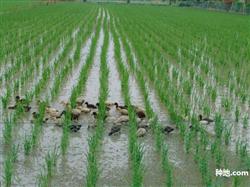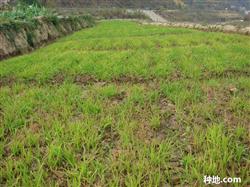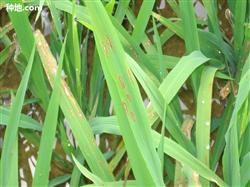Introduction: pollution-free control methods of rice diseases and insect pests

The methods of non-pollution prevention and control of rice diseases and insect pests are as follows: (1) the technique of punching and killing borer in rice field: during the peak period of pupation of borer in winter (March 20 in southern Jiangxi, April 1 in central Jiangxi, April 10 in northern Jiangxi), ploughing winter fallow field and green manure field, soaking in deep water, so that the borer can not emerge normally, so as to achieve the purpose of killing pupae and killing borer and reducing the occurrence base. Winter farming in time after harvest also has a certain effect on killing borer. (2) the selection of disease prevention techniques of resistant varieties: selecting varieties resistant to rice blast and false smut, eliminating varieties with poor resistance and susceptibility, and timely rotation of varieties with long planting years are the fundamental measures to prevent rice blast and false smut. (3) seed disinfection and prevention of diseases and insect pests: early rice to prevent evil seedling disease and rice blast, intermittent soaking seeds with 2000-3000 times 25% imidamide EC for 24 hours, direct germination and sowing; middle and late rice to prevent rice thrips, rice planthopper and rice gall midge, use imidacloprid mixed with bud grain, the dosage is 10% imidacloprid wettable powder 10 grams mixed with rice seeds 2.5 kg. (4) techniques of super grafting medicine in seedling field to prevent field diseases and insect pests: 2-3 days before seedling transplanting, super marriage medicine was sprayed to prevent or reduce the occurrence of diseases and insect pests in the field. For early rice, 40% triazophos EC 100 ml or 5% fipronil suspension 60 ml plus 75% tricyclazole wettable powder 60 g spray 30 kg of water to prevent rice borer and rice blast, etc.; middle and late rice mu with 40% triazophos EC 100 ml or 5% fipronil EC 60 ml plus 10% imidacloprid wettable powder 40 g 30 kg water spray to prevent rice thrips and borer. (5) Rice and duck co-breeding and pest control and grass control techniques: at the peak tillering stage of rice, 15 ducks of 15 days old were released in each mu of rice field, and ducks were harvested before breaking. The occurrence of sheath blight, rice planthopper and weeds can be reduced through the feeding and activities of ducks. (6) the technique of trapping and killing Chilo suppressalis with sexual attractants: the male moths of Chilo suppressalis were killed by sexual attractants, so that the females could not mate and reproduce normally, reduce the base of offspring and reduce the harm. In the period of the main damage generation of Chilo suppressalis, put a trap per mu, with a built-in trap, once in each generation, the trap should be 30 cm higher than rice. (7) Light trapping and killing pest technology: a frequency vibrating insecticidal lamp is installed every 30 to 50 mu of rice fields, the bottom of which is 1.5 meters from the ground, to trap and kill many kinds of rice pests, such as Chilo suppressalis, Rice planthopper and other rice pests. From mid-April to early October, the lights are turned on from dark to 12:00 every night. (8) Biopesticide application technology: popularize the use of bio-pesticides to control rice diseases and insect pests, control sheath blight and rice false smut with Jinggangmycin or the mixture of Jinggangmycin and Bacillus cereus, control rice blast with Bacillus subtilis or spring reticulomycin, control bacterial leaf spot with agricultural streptomycin, control rice borer and rice leaf roller with Bacillus thuringiensis and avermectin. Biological pesticides should be used 2-3 days earlier than chemical pesticides to avoid high temperature and drought. (9) Protection and utilization of natural enemies to control pests: protect and utilize natural enemies in rice fields and give full play to the role of natural enemies in controlling pests. Common measures include: planting beans on the ridge of the field to protect and utilize natural enemies such as spiders, protecting frogs, releasing Trichogramma, and so on. (10) Scientific drug application technology: according to different diseases and insect pests of different crops, the varieties of chemical pesticides with high efficiency, low toxicity and low residue should be correctly selected to prescribe the right medicine. Triazophos, butene fipronil, fipronil, etc.; Propiophos for rice leaf roller; thiazone and thiazide for rice planthopper; tricyclazole and rice blast for rice blast; diphenyl ether for sheath blight and rice false smut Metronazole; thiobacillus copper and trichloroisocyanuric acid for bacterial streak disease. The synergist was added to the solution to enhance the adhesion, diffusion and penetration of pesticides, improve the efficacy and reduce the dosage of pesticides. Common synergists are azone, organosilicon and so on. In the break stage of rice, the mixed drug was used to control the rice, so as to reduce the times of drug use and improve the control effect. Early rice mainly controls stem borer, rice leaf roller, rice planthopper and rice blast, while late rice mainly controls stem borer, rice planthopper and rice false smut. When chemical pesticides are used to control diseases and insect pests, chemical pesticides should be applied at the stage of young larvae and the early stage of disease. The safe interval should be carried out when the pesticide is applied at the ear stage. Click to get massive rice planting technology click to get massive grain planting technology
- Prev

How to control blight when raising rice seedlings
How to control blight when raising rice seedlings? Although the rice dry nursery seedling bed is not easy to rot rice seedlings, it is most likely to die of blight disease, which is 20%, 30% and more than 50%, respectively. The following measures can be taken to effectively control the disease. 1. Adjust the acid of the soil: neutral and alkaline soil, sowing.
- Next

Is there any good way to control diseases and insect pests in rice?
Is there any good way to control diseases and insect pests in rice? The success or failure of rice pest control plays a vital role in rice yield. For the prevention and control of rice diseases and insect pests, the first is to select varieties resistant to diseases and insect pests; the second is to fertilize reasonably and increase the application of organic fertilizer, phosphorus and potassium fertilizer; the third is to use water scientifically to keep the field dry and rainy.
Related
- The first cup of black tea in spring, the flavor and history of tea gardens in Kenya, Africa
- The computer can not only choose potatoes, but also grow tea rice. AI will grow winter oolong tea champion.
- It is not only the inflated tea bitten by insects, but also engraved with the four seasons tea in Beipu.
- The Oriental Beauty Tea Festival in Zhuxian County takes the stage at the weekend to experience the plus-size feast of oil tea.
- & quot; Oriental Beauty Tea & Exploration of Emei in Hsinchu, the hometown of quot;
- The new variety of strawberry "Tainong 1" dessert is the first choice with mellow aroma. Crimson gorgeous
- History of Tea in Taiwan: from Wild Inner Mountain to Export Tea Garden
- Two types of Taiwan Oriental Beauty Black Tea won the British three-Star Award for Childhood Tea Xiang Zhang Jiaqi changed from pilot to champion tea maker.
- Banana species and varieties: the planting history of Taiwan Xianren banana and dwarf banana is long, is banana disease resistant?
- Coffee planting Technology: Qianjie Coffee from Seedling to harvesting

